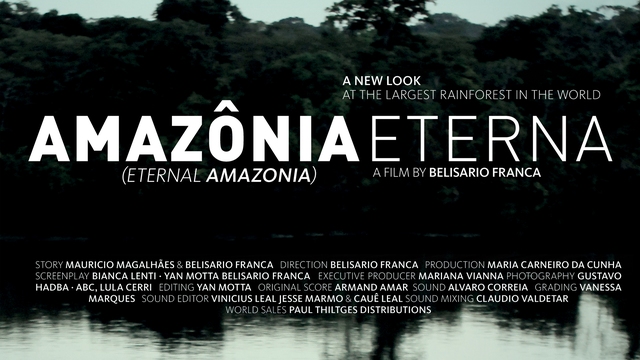Amazonia Eterna
How local indigenous commerce might save the Rainforest.
 The sun glints on crystal clear waters, mist floats above the towering falls that flow into a lush green basin. Today, the incomparably beautiful Amazon rainforest is a vast laboratory for experiments that are redefining the relationship between humans and nature. But what's the worth of this invisible commodity? And who should profit from it? This glorious, cinematic film looks for answers as it plunges into a sensory journey through the rainforest.
The sun glints on crystal clear waters, mist floats above the towering falls that flow into a lush green basin. Today, the incomparably beautiful Amazon rainforest is a vast laboratory for experiments that are redefining the relationship between humans and nature. But what's the worth of this invisible commodity? And who should profit from it? This glorious, cinematic film looks for answers as it plunges into a sensory journey through the rainforest.


 "Flying over the Amazon, you think it's impossible to destroy it. But every ecosystem has a point of no return", environmental expert Paulo Moutinho says gravely. The size of Western Europe, the Amazon holds 20% of the world's fresh water and 10% of its animal and plant species. The fate of this vast rainforest is the fate of the whole planet. As a tribal warrior of the Amazon's Yepamasa people extols, "we are all the descendants of these waters".
But today conservationists and the authorities are waking up to the value of the ancient tribal knowledge within the Amazon's indigenous communities. "In many tribes when a new child is born they plant a fruit tree, so that the child can eat from it later", one environmentalist praises. As a native Indian of the Amazon explains, "we educate our children with our traditional knowledge and teach them to preserve nature". Tradition, new technology, enterprise and sustainable economics are powering the way for man and nature to co-exist harmoniously.
The Amazon can be "viewed as something that represents an economic opportunity", as part of "the green economy". Amongst the lush canopy and babbling waterways lies a treasure trove of economic resources. "One gram of brown spider venom is worth $25,000. There is an Amazon beetle worth $8000." Experts now argue that unless we place financial value to the rainforest while it stands, it will always be worth more cut down. Macro-initiatives making use of local tribal knowledge are bringing a renewed life to communities across the Amazon basin. "We've recorded 632 species and we've only looked at 7% of the forest", a local forester says proudly.
"The debate on the Amazon is not about what can or cannot be done. It is about how things can be done differently". From fishing to forestry to farming, this sumptuous doc offers a positive and fresh insight to a well-worn global dilemma.
LEARN MORE.
"Flying over the Amazon, you think it's impossible to destroy it. But every ecosystem has a point of no return", environmental expert Paulo Moutinho says gravely. The size of Western Europe, the Amazon holds 20% of the world's fresh water and 10% of its animal and plant species. The fate of this vast rainforest is the fate of the whole planet. As a tribal warrior of the Amazon's Yepamasa people extols, "we are all the descendants of these waters".
But today conservationists and the authorities are waking up to the value of the ancient tribal knowledge within the Amazon's indigenous communities. "In many tribes when a new child is born they plant a fruit tree, so that the child can eat from it later", one environmentalist praises. As a native Indian of the Amazon explains, "we educate our children with our traditional knowledge and teach them to preserve nature". Tradition, new technology, enterprise and sustainable economics are powering the way for man and nature to co-exist harmoniously.
The Amazon can be "viewed as something that represents an economic opportunity", as part of "the green economy". Amongst the lush canopy and babbling waterways lies a treasure trove of economic resources. "One gram of brown spider venom is worth $25,000. There is an Amazon beetle worth $8000." Experts now argue that unless we place financial value to the rainforest while it stands, it will always be worth more cut down. Macro-initiatives making use of local tribal knowledge are bringing a renewed life to communities across the Amazon basin. "We've recorded 632 species and we've only looked at 7% of the forest", a local forester says proudly.
"The debate on the Amazon is not about what can or cannot be done. It is about how things can be done differently". From fishing to forestry to farming, this sumptuous doc offers a positive and fresh insight to a well-worn global dilemma.
LEARN MORE.
WATCH MORE.
JOIN THE DISCUSSION.
 Official Selection - FIFE - Environmental International Film Festival, Paris, France: 2013
Official Selection - FIFE - Environmental International Film Festival, Paris, France: 2013
 Official Selection - Green Film Fest, Argentina 2013
Official Selection - Green Film Fest, Argentina 2013
 Official Selection - IDFA - Docs for Sale, 2013
Official Selection - IDFA - Docs for Sale, 2013
 Official selection - FIPA, The International Festival of Audiovisual Programmes, France 2013
Official selection - FIPA, The International Festival of Audiovisual Programmes, France 2013
 Official Selection - 16th Brooklyn Film Festival
Official Selection - 16th Brooklyn Film Festival
 Best Documentary, BRAFFTV, Brazilian Film & Television Festival of Toronto, Canada, 2013
Best Documentary, BRAFFTV, Brazilian Film & Television Festival of Toronto, Canada, 2013
 Official programme - Good Planet - Rio+20, Rio De Janeiro, Brazil 2012
Official programme - Good Planet - Rio+20, Rio De Janeiro, Brazil 2012





